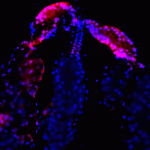Link to Pubmed [PMID] – 33432714
Link to DOI – 10.1111/mec.15798
Mol Ecol 2021 Apr; 30(7): 1594-1611
Horizontal gene transfer from viruses to eukaryotic cells is a pervasive phenomenon. Somatic viral integrations are linked to persistent viral infection whereas integrations into germline cells are maintained in host genomes by vertical transmission and may be co-opted for host functions. In the arboviral vector Aedes aegypti, an endogenous viral element from a nonretroviral RNA virus (nrEVE) was shown to produce PIWI-interacting RNAs (piRNAs) to limit infection with a cognate virus. Thus, nrEVEs may constitute a heritable, sequence-specific mechanism for antiviral immunity, analogous to piRNA-mediated silencing of transposable elements. Here, we combine population genomics and evolutionary approaches to analyse the genomic architecture of nrEVEs in A. aegypti. We conducted a genome-wide screen for adaptive nrEVEs and searched for novel population-specific nrEVEs in the genomes of 80 individual wild-caught mosquitoes from five geographical populations. We show a dynamic landscape of nrEVEs in mosquito genomes and identified five novel nrEVEs derived from two currently circulating viruses, providing evidence of the environmental-dependent modification of a piRNA cluster. Overall, our results show that virus endogenization events are complex with only a few nrEVEs contributing to adaptive evolution in A. aegypti.

